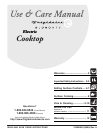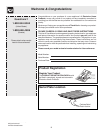
4
The use of undersized utensils will expose a portion of the
surface heating unit to direct contact and may result in
ignition of clothing. Proper relationship of utensil to element
will also improve efficiency.
• Utensil Handles Should Be Turned Inward and Not
Extend Over Adjacent Surface Units. To reduce the risk of
burns, ignition of flammable materials, and spillage due to
unintentional contact with the utensil.
• Never Leave Surface Units Unattended. Boilovers cause
smoking and greasy spillovers that may ignite, or a pan that
has boiled dry may melt.
• Protective Liners. Do not use aluminum foil to line any part
of the appliance. Only use aluminum foil as recommended for
baking if used as a cover placed on the food. Any other use
of protective liners or aluminum foil may result in a risk of
electric shock or fire or short circuit.
• Glazed Cooking Utensils. Only certain types of glass,
glass/ceramic, ceramic, earthenware, or other glazed
utensils are suitable for range top service without breaking
due to the sudden change in temperature. Check the
manufacturer's recommendations for cooktop use.
• Do Not Use Decorative Surface Element Covers. If an
element is accidentally turned on, the decorative cover will
become hot and possibly melt. Burns will occur if the hot
covers are touched. Damage may also be done to the
appliance.
FOR CERAMIC-GLASS COOKTOP ONLY
• Do Not Clean or Operate a Broken Cooktop. If cooktop
should break, cleaning solutions and spillovers may
penetrate the broken cooktop and create a risk of electric
shock. Contact a qualified technician immediately.
• Clean Cooktop with Caution. If a wet sponge or cloth is
used to wipe spills on a hot cooking area, be careful to avoid
a steam burn. Some cleaners can produce harmful fumes if
applied to a hot surface.
• Do Not Place Hot Cookware on Cold Cooktop Glass. This
could cause glass to break.
• Do not slide pan across the cooktop surface. They may
scratch the cooktop surface.
• Do Not Let Pans Boil Dry. This may cause permanent
damage in the form of breakage, fusion, or marking that can
affect the ceramic-glass cooktop. (This type of damage is
not covered by your warranty).
Important Safety Instructions
IMPORTANT SAFETY NOTICE
The California Safe Drinking Water and Toxic Enforcement Act requires the Governor of California to publish a list of
substances known to the state to cause cancer, birth defects or other reproductive harm, and requires businesses to warn
customers of potential exposure to such substances.
Fig.1 - 30” Model - Cooktop
Appearance
Fig. 2 - 36” Model - Cooktop Appearance
About the Ceramic Glass Cooktop
The ceramic cooktop has radiant surface elements located below the surface of the
glass. The design of the ceramic cooktop outlines the area of the surface element
underneath. Make sure the diameter of the pan matches the diameter of the element
outline on the cooktop (See Figs. 1 & 2).
Heat is transferred up through the surface of the cooktop to the cookware. Only flat-
bottom cookware should be used. The type and size of cookware, the number of surface
elements in use and their settings are all factors that will affect the amount of heat that
will spread to areas beyond the surface elements. The areas surrounding the elements
may become hot enough to cause burns.
About the Radiant Surface Elements
The element temperature rises gradually and evenly. As the temperature rises, the
element will glow red. To maintain the selected setting, the element will cycle ON and
OFF. The heating element retains enough heat to provide a uniform and consistent heat
during the OFF cycle. For efficient cooking, turn OFF the element several minutes
before cooking is complete. This will allow residual heat to complete the cooking
process.
Setting Surface Controls
bridge
element
s
p
e
e
d
e
l
e
m
e
n
t
expandable
element
expandable
element
ELEMENTON
Right
Rear
Right
Front
Center
Rear
Left
Rear
Left
Front














